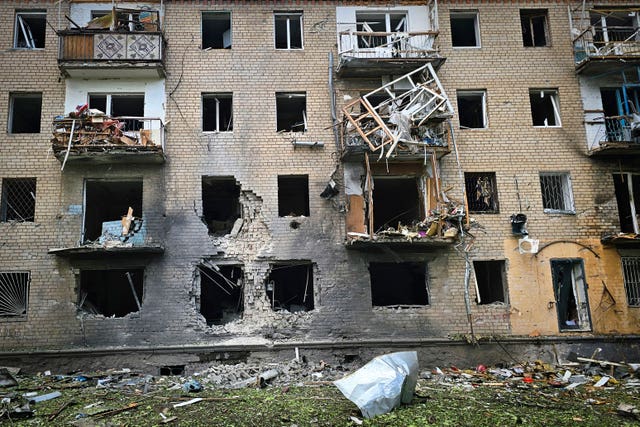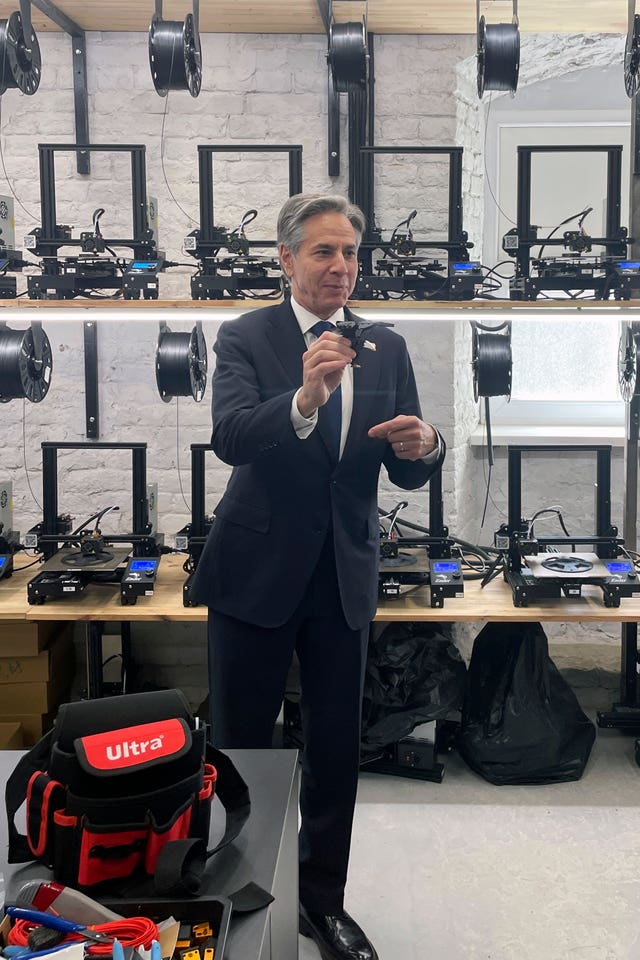Ukrainian units locked in street battles with the Kremlin’s forces in a key north-eastern town have halted the Russian advance, military officials in Kyiv said.
However, a senior Moscow official said the frontline push had enough resources to keep going.
Russian attempts to establish a foothold in the town of Vovchansk, which is among the largest towns in the north-eastern Kharkiv region with a pre-war population of 17,000, “have been foiled”, Ukraine’s general staff said in a midday report.
It was not possible to independently verify the claim.

Six people were injured on Thursday in one Russian daylight attack on Vovchansk using cluster munitions, local officials said, as emergency workers and volunteers were rescuing people affected by shelling. Among the injured were two medics, he said.
Ukrainian authorities have evacuated some 8,000 civilians from the town. The Russian army’s usual tactic is to reduce towns and villages to ruins with aerial strikes before its units move in.
Vovchansk, located just three miles from the Russian border, has been a hotspot in the fighting in recent days.
Russia launched an offensive in the Kharkiv area late last week, significantly adding to the pressure on Ukraine’s outnumbered and outgunned forces which are waiting for delayed deliveries of crucial weapons and ammunition from western partners.
Russia has also been testing defences at other points along the roughly 620-mile front line snaking from north to south through eastern Ukraine.
That line has barely changed over the past 18 months in what has become a war of attrition.
Recent Russian attacks have come in the eastern Donetsk region, as well as the Chernihiv and Sumy regions in the north and in the southern Zaporizhzhia region. The apparent aim is to stretch depleted Ukrainian resources and exploit weaknesses.
Latest Defence Intelligence update on the situation in Ukraine – 16 May 2024.
Find out more about Defence Intelligence's use of language: https://t.co/1NsPGy2eF6 #StandWithUkraine 🇺🇦 pic.twitter.com/5aL0rKVLBk
— Ministry of Defence 🇬🇧 (@DefenceHQ) May 16, 2024
Nato’s top military officer believes that Russia’s armed forces are incapable of any major advance.
“The Russians don’t have the numbers necessary to do a strategic breakthrough, we don’t believe,” US General Christopher Cavoli – Nato’s Supreme Allied Commander Europe – told reporters after a meeting of the organisation’s top military brass in Brussels.
“More to the point, they don’t have the skill and the capability to do it; to operate at the scale necessary to exploit any breakthrough to strategic advantage.”
Asked whether Russia might be about to launch its anticipated summer offensive early, Gen Cavoli said “we can never be sure”, but he added that “what we don’t see is large numbers of reserves being generated some place” which would be needed for any such offensive.
Ukraine has repeatedly tried to strike behind Russian lines, often using drones, though Russia’s response to the new technology used in unmanned vehicles has improved in recent months.
Russian naval aircraft on Thursday destroyed 11 Ukrainian sea drones heading towards annexed Crimea in the western Black Sea, Russia’s Defence Ministry said, according to state news agency TASS. Kyiv made no comment.

Ukrainian President Volodymyr Zelensky met his top military commanders in Kharkiv on Thursday and said the region “is generally under control”.
However, he acknowledged on social media that the situation is “extremely difficult” and said Ukraine was again strengthening its units in Kharkiv.
“We clearly see how the occupier is trying to distract our forces and make our combat work less concentrated,” Mr Zelensky said in his nightly video address on Wednesday.
Former Russian defence minister and now head of the presidential Security Council Sergei Shoigu insisted Russian troops are pushing the offensive in many directions and that “it’s going quite well”.
“I hope we will keep advancing. We have certain reserves for the purpose, in personnel, equipment and munitions,” he said in televised remarks.
The Institute for the Study of War, a Washington-based think tank, calculated that Russian forces attacking in Kharkiv have advanced no more than five miles from the shared border.

It reckons Moscow’s main aim in Kharkiv is to create a “buffer zone” that will prevent Ukrainian cross-border strikes on Russia’s neighbouring Belgorod region.
US secretary of state Antony Blinken, in a two-day visit to Kyiv this week, sought to reassure Ukraine of continuing American support. He announced a 2 billion dollar arms deal, with most of the money coming from a package approved last month.
Ukrainian officials say their needs are urgent and Western partners have vowed to expedite deliveries of military hardware.
Nato Military Committee chairman Rob Bauer urged senior officers from the 32-nation alliance to send more arms and ammunition to Ukraine, even if that means ignoring weapons stock guidelines.
“If faced with a choice between meeting the Nato capability targets or supporting Ukraine, you should support Ukraine,” he told a meeting of top defence brass in Brussels. “Stocks can and will be replenished. Lives lost are lost forever.”




Comments: Our rules
We want our comments to be a lively and valuable part of our community - a place where readers can debate and engage with the most important local issues. The ability to comment on our stories is a privilege, not a right, however, and that privilege may be withdrawn if it is abused or misused.
Please report any comments that break our rules.
Read the rules hereLast Updated:
Report this comment Cancel